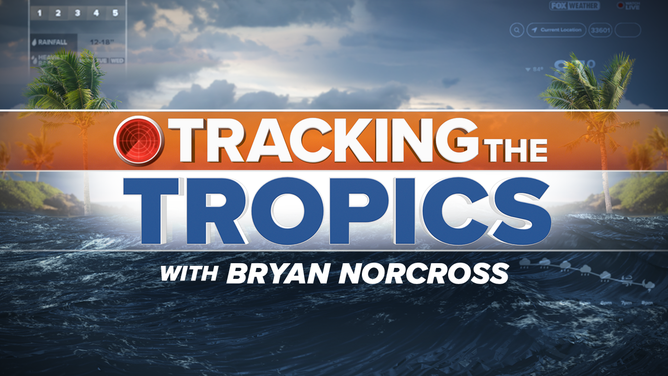Sprawling Nicole to impact most of Florida with coastal flooding, high winds, heavy rain
It's a close call whether Nicole can join the 1935 storm in the record book as a landfalling November hurricane. But the development of thunderstorms near the center of circulation gives it a chance to reach hurricane strength.

The podcast Tracking the Tropics with Bryan Norcross is now available to stream.
(FOX Weather)
Updated at 8 a.m. Eastern:
Oddball Nicole is still an expansive circulation, and now the system is finally starting to develop a core. This change in structure will allow it to strengthen. Tropical-storm-force winds extend some 300 miles from the center of circulation, which means the system's energy is spread over a wide expanse of the ocean. This broad sweep of wind energy will drive a significant storm surge toward the Florida and Southeast U.S. coast, no matter how much the central core of the storm develops.
It's very unusual for a tropical system to approach the Florida peninsula from the east in November. With one exception, landfalling storms have all come from the south or the southwest this time of year. The exception was also a freaky storm, though in a different way than Nicole. It was a full-fledged hurricane that tracked from near Bermuda over downtown Miami in 1935 with 100 mph winds.
It's a close call whether Nicole can join the 1935 storm in the record book as a landfalling November hurricane. But the development of thunderstorms near the center of circulation gives it a chance to reach hurricane strength.
HOW TO WATCH FOX WEATHER ON TV

(FOX Weather)
Nicole now appears to be evolving from its subtropical storm status into a tropical system. In the subtropical configuration, the system's strongest winds have been in its outer bands. The question is, can strong thunderstorm cells keep developing near its center, which would allow Nicole to transition into a more typical tropical storm? Only if that happens would Nicole have the structure needed to reach hurricane strength.
The National Hurricane Center's forecast of Nicole at or near hurricane strength when it reaches the Florida coast overnight tomorrow night/Thursday morning is based on the idea that the system will continue to evolve and become fully tropical. Only then could the system tap into the heat from the ocean waters near the Bahamas. But no matter how this core development plays out, the wide-ranging effects from the storm will impact Florida.
To be clear, there is zero chance that Nicole could blow up into a Hurricane Ian or Dorian. This is a very different kind of storm surrounded by different atmospheric conditions.
Before Nicole reaches Florida, it will impact the northern Bahamas. Winds will increase from the northeast then north over Abaco and Grand Bahama islands through the day today and overnight. An ocean water rise of 4 to 6 feet above normal tide levels will impact northeast and north-facing shores.
Winds are already blowing off the ocean onto the land along most of the Florida east coast, which is pushing ocean water toward the coast and into bays, harbors, and rivers open to the Atlantic. The strength of that onshore push of wind is going to increase tomorrow and peak over the eastern peninsula overnight tomorrow. Even after the center of Nicole is over land, strong onshore winds will continue.
The relentless onshore flow means the ocean water will stay high for the next few days. The National Hurricane Center is forecasting the ocean-level increase to reach 3 to 5 feet above normal high tide from the southern coast of Georgia south to Palm Beach County, Florida.

(FOX Weather)
The St. Johns River in North Florida is still above normal from the fresh-water flooding caused by Hurricane Ian. Now Nicole's winds will push salt water into the river at Jacksonville, backing up the northern part of the waterway. Low-lying areas near the river are likely to be flooded again.
This water rise caused by the wind is called storm surge. Low-lying areas, areas where dunes were destroyed by Hurricane Ian, and open waterways will all be affected by the rising ocean water. Pay close attention to local alerts concerning flooded areas. And remember that the flooding is salt water, which is very damaging to cars. If you drive through even a salt-water puddle, try to wash off the bottom of your car.
The potential for hurricane-force wind gusts late Wednesday into Thursday continues from just north of Cape Canaveral to about Fort Lauderdale. Gusty winds of 40 to 60 mph are likely over much of the Florida peninsula north and to the right of the track of the center of circulation.
These persistent winds can cause local power outages. Be ready for that possibility late tomorrow into Thursday.
Rainfall will pile up to 7 inches in some parts of the Florida peninsula, but it's not expected to cause widespread flooding like Hurricane Ian.
Some winds of 40-50 mph might impact the Gulf coast before Nicole swings to the north, but significant impacts beyond a slight water rise are not expected. The duration of the onshore winds should be fairly short.
Don't focus on the peak winds in the storm. No matter what, Nicole will be a disruptive storm in Florida from Wednesday afternoon through at least Thursday. By late Thursday, a strong dip in the jet stream will start to lift Nicole to the north. On Friday or Saturday, it should merge with a front along the East Coast.
Moisture from Nicole combined with the cold front is forecast to produce a swath of heavy rain through the Northeast and New England.
FOX Weather Hurricane Specialist Bryan Norcross has a podcast, Tracking the Tropics with Bryan Norcross, available now on FOX News Audio. You can get it on your device by clicking here.